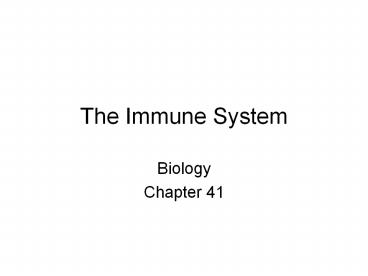The Immune System PowerPoint PPT Presentation
1 / 19
Title: The Immune System
1
The Immune System
- Biology
- Chapter 41
2
- Pathogen-disease causing agent (various types of
bacteria, viruses, fungi, protists) - Body uses both specific and nonspecific defense
mechanisms to prevent infection and destroy
pathogens
3
Nonspecific defenses
- Do not target a specific pathogen
- Skin and mucous membranes (line digestive system,
lungs, nasal passages)
4
Nonspecific defenses
- 2. Inflammatory response-suppress infection and
speed recovery. Injured cells release Histamine
which increases blood flow to area bringing more
white blood cells (WBCs). Also causes swelling
and redness in the infected area
5
Nonspecific defenses
- Temperature response/Fever
- many bacteria do not grow well in higher temps
however, too high a fever can result in
destruction of important enzymes
6
Nonspecific defenses
- 4. Proteins
- Complement system- proteins that circulate in the
blood and when they encounter a pathogen they
form a structure that ruptures the cell membrane
of the pathogen. - Interferon- protein released by cells infected
with a virus, causes nearby cells to produce an
enzyme that prevents viruses from making proteins
and RNA.
7
5. WBCs- most important counterattacks carried
out by 3 kinds of WBCs
- - Neutrophils-most abundant type, engulf and
destroy pathogens - - Macrophages-ingest and kill pathogens,
concentrated especially in spleen and lungs
8
- - Natural killer cells-destroy an infected cell
by puncturing the cell membrane causing water to
rush into the cell and burst. One of the best
defenses against cancer, can detect and kill
cancer cells before a tumor develops
9
Specific Immune Responses
- Cytotoxic T cells-attack and kill infected cells
- B cells- label invaders for later destruction by
macrophages - Helper T cells- activate both cytotoxic T cells
and B cells
cytotoxic T-cell
tumour cell
10
Two distinct processes work together in the
immune response
- B cell response which is a passive, humoral
defense that aids in the removal of pathogens - T cell response, an active, cell-mediated defense
that involves the destruction of pathogens by
cytotoxic T cells
11
Interactions Between Responses
12
- Antigen Proteins or other components on the cell
surface of the pathogen. WBCs have receptor
proteins that bind to specific antigens. - Antibody Y-shaped molecule produced by plasma
cells upon exposure to specific antigen
13
Immune Responses
- Immune responses
14
Disease Transmission
- Person-to person contact (contagious/communicable)
- Air
- Food
- Water
- Animal Bites
15
Kochs Postulates 4 step procedure for
identifying specific pathogens
- Pathogen must be found in an animal with the
disease, not a healthy animal - Pathogen is isolated and cultured
- Pathogen is injected into healthy animal animal
must develop the disease - Pathogen taken from second infected animal is
cultured and it must be the same as the original
pathogen
16
Resistance to a disease is called immunity
- Vaccination is a medical procedure used to
produce immunity. - Edward Jenner developed a vaccine against
smallpox. - A small amount of dead or modified pathogen is
injected into the body to produce an immune
response without symptoms of the infection. - Your body develops antibodies and memory cells
against the pathogen (measles, polio, tetanus,
diphtheria, etc).
17
- Some pathogens have the ability to mutate over
time. The viruses produce new antigens that your
body does not recognize (antigen shifting). That
is why you can get the flu, even if you have had
a vaccination or already had it before.
18
Disorders of the Immune System
- Autoimmune disease-body attacks its own cells
(multiple sclerosis, rheumatoid arthritis,
Graves disease, Type I Diabetes). - AIDS is caused by HIV (human immunodeficiency
virus). HIV invades helper T cells causing them
to produce more virus and then die. - HIV is transmitted through HIV-infected WBCs in
body fluids and can be exchanged through sexual
contact and/or sharing of needles
19
3. Allergic Reactions
- An allergy is the bodys overreaction to a
normally harmless antigen. Most allergic
reactions cause cells to produce histamines,
which cause swelling, redness, increased mucus
production, runny nose, itchy eyes and congestion - Most allergy medicines contain antihistamines,
which prevent the action of the histamine. - Severe allergic reactions, like asthma and bee
stings, can be life threatening.

